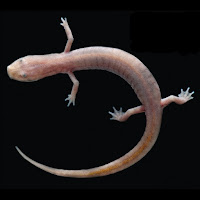Abstract
The transition from carnivory to omnivory is poorly understood. The ability to feed at more than one trophic level theoretically increases an animal’s fitness in a novel environment. Because of the absence of light and photosynthesis, most subterranean ecosystems are characterized by very few trophic levels, such that food scarcity is a challenge in many subterranean habitats. One strategy against starvation is to expand diet breadth. Grotto Salamanders (Eurycea spelaea (Stejneger, 1892)) are known to ingest bat guano deliberately, challenging the general understanding that salamanders are strictly carnivorous. Here we tested the hypothesis that grotto salamanders have broadened their diet related to cave adaptation and found that, although coprophagous behavior is present, salamanders are unable to acquire sufficient nutrition from bat guano alone. Our results suggest that the coprophagic behavior has emerged prior to physiological or gut biome adaptations.
Keywords: Guano feeding, salamander, evolution, physiology, behavior
 |
| Figure 1. Eurycea spelaea showing troglobitic characters, lack of pigmentation and microphthalmy. Scale bar: 0.5 cm. |
Daphne Soares, Rachel Adams, Shea Hammond, Michael E. Slay, Danté B. Fenolio and Matthew L. Niemiller. 2017. Evolution of Coprophagy and Nutrient Absorption in A Cave Salamander. Subterranean Biology. 24; 1-9. DOI: 10.3897/subtbiol.24.15013

